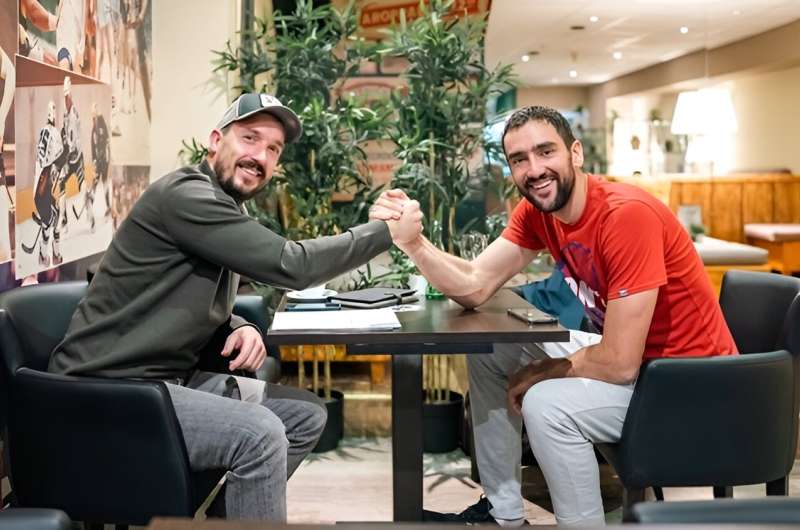This article has been reviewed according to Science X's editorial process and policies. Editors have highlighted the following attributes while ensuring the content's credibility:
fact-checked
trusted source
proofread
What makes a Grand Slam champion? Research finds three key guidelines for tennis coaches

To provide adequate support to young athletes, it is important to understand their development path. Over the years, researchers have recognized the significance of tracking all processes aimed at optimizing athletes' progress and overall success. In a new study by Mario Oršolić, Dr. Petar Barbaros, and Dr. Dario Novak, 30 tennis players at different levels of success were interviewed, including 10 Grand Slam winners, to understand how they got into the sport and what drove their success.
The research, published in Frontiers in Sports and Active Living, sought to deepen the understanding of specialization in tennis by exploring the experiences of tennis players at different levels of success. By analyzing their stories, the researchers aimed to contribute to a wider knowledge on the development of tennis players, as well as providing valuable insight for individual sports careers
The study reveals that the choice to play tennis among all the interviewed participants arose from a set of circumstances combined with personal preferences.
Grand Slam winners often assign their success to a combination of factors. A significant role is certainly played by their early experiences in tennis. Engaging in other sports during childhood and adolescence has several advantages, even for those athletes who eventually specialize in one sport such as tennis. Playing various sports helps develop a wider range of motor skills. These experiences added to their overall sportsmanship, mental resilience, and the ability to adapt in different situations on tennis courts.
The size of the city where an athlete is born can potentially affect his future athletic achievements, however, it presents only one of many factors that contribute to success in tennis. Larger cities can offer a wider selection of training partners, allow tennis players to train with individuals with different playing styles and skills, as well as provide better facilities available for training and a greater number of higher-quality coaches.
However, it must be noted that despite the fact that larger cities offer numerous advantages, they are not a guarantee for success. Many Grand Slam winners came from smaller cities or less developed regions. However, they believed that after the age of 14 the sports environment should be changed from smaller to a larger one.
Making the right decisions at the right time is crucial for players
Tennis players at the second and third level of success were characterized by premature narrow specialization and insufficient international competitions aimed at gaining more experience. Going to private tennis academies and centers with specialized programs that meet the needs of tennis players at different levels of success is perceived as one of the key decisions.
Although there are many positive aspects of this training, there are also potential shortcomings, such as the high costs of training at elite academies and burnout among young players due to intensive training schedules. In addition, many players felt lonely at academies due to separation from family and friends.
Due to this, local level tennis clubs play an important role in the development of young tennis players. They should provide a social environment in which young players can make friends who share their passion for tennis. Such friendships add to the feeling of togetherness and thus make the overall tennis environment more pleasant.
Having fun and showing dedication in the training process are very significant not only in tennis, but in any other sport as well. When someone enjoys what they are doing, they are more likely to invest time and effort in it. Grand Slam winners were more enthusiastic and dedicated in their training when compared to participants at the second and third level of success, and that had positive effects on their commitment, performance, and overall success.
Targeted and more intensive training is recommended later in adolescence
The relationship between more intensive training in addition to pre-adolescent specialization and achieving elite-level status in individual sports such as tennis presents a complex and highly debated topic. Research and opinions differ on whether early specialization is required for achieving elite status. Many experts suggest that early diversification, which includes participating in many sports and activities, can be advantageous in the long term, as well as contribute to better success for athletes.
In this study, Grand Slam winners articulated against early specialization and intensive training at a young age. Likewise, they highlighted the importance of a more versatile sports development during childhood and adolescence.
The optimal time for targeted and intensive training in tennis can vary, and it depends on several factors, including the age of the player, skill level, goals, and physical condition. However, all research participants agree that postponing specialization until later adolescence allows for developing a wider range of athletic skills that help prevent injuries resulting from overload, as well as reduce the physical and mental exertion of early intensive specialization.
More information: Mario Oršolić et al, What makes a Grand Slam champion? Early engagement, late specialization and timely transition from having fun to dedication, Frontiers in Sports and Active Living (2023). DOI: 10.3389/fspor.2023.1213317




















